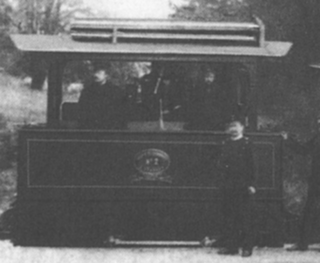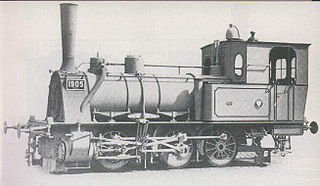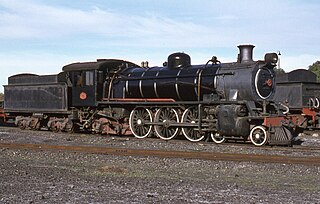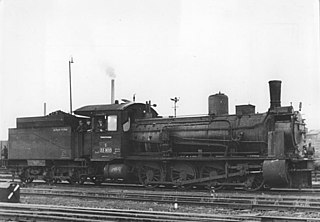History
The MARSCHALL VORWÄRTS was delivered in 1848 by the Berlin locomotive works, Lokomotivfabrik F. Wöhlert, with factory number 1 and was given the running number 4 by the Mecklenburg Railway Company (Mecklenburgische Eisenbahngesellschaft). On its nationalisation, the locomotive was renumbered to 42 and, on the introduction of a new numbering plan in 1895, to number 1. In 1866 the locomotive was given a new boiler and was retired in 1900. During a visit to the workshop the driving axle was incorrectly fitted by mistake, with the result that the locomotive ran backwards through the wall of the shed during the ensuing test run.
The locomotives SCHWAAN and NEBEL were delivered in 1850 by Borsig and given railway numbers 9 and 10. On nationalisation they were renumbered to 45 and 46. NEBEL was retired in 1890, whilst SCHWAAN continued in service until 1898 and from 1895 carried the number 3.
HERTHA and FREYA were also delivered by Borsig - in 1860 - and allocated numbers 23 and 24. They were renumbered to 55 and 56 on nationalisation and, subsequently, to 4 and 5 in 1895. The engines were retired in 1894 and 1899.
In 1863 Egestorff supplied no. 25, HULDA. The engine was allocated number 57 after nationalisations and number 5 in 1895. In 1901 she was retired.
The performance of these locomotives was sufficient for level routes. They were mainly placed in charge of passenger trains on the Hagenow–Rostock line and occasionally hauled mixed trains.
Design features
The locomotives had an inside forked frame (Gabelrahmen). The boiler barrel comprised two (and on HULDA three), shells. The steam dome was located on the centre one, and on HULDA on the front shell.
On HULDA the firebox extended under the trailing axle by means of a sloping base in order to achieve the greatest possible grate area. Apart from MARSCHALL VORWÄRTS which had a conical chimney, all the engines had long cylindrical smokestacks.
The two-cylinder wet steam engine was located on the outside horizontally. The Stephenson valve gear was inside. On the SCHWAAN and the NEBEL the cylinders were angled and attached to the smokebox, the valve gear was external as well. HULDA had a screw reversing gear.
The suspension on the driving wheels was achieved by leaf springs underneath and was linked to the leaf springs of the leading wheels using a compensating lever. HULDA had a transverse leaf spring under the trailing axle, this axle was unsprung on the other engines.
The locomotives were coupled to four-wheeled tenders which had a water capacity of 4.45 m3 and 3 t coal tank.

The Great Western Railway 3252 or Duke Class were 4-4-0 steam locomotives with outside frames and parallel domed boilers. They were built in five batches between 1895 and 1899 for express passenger train work in Devon and Cornwall. William Dean was their designer, possibly with the collaboration of his assistant, George Jackson Churchward. Four prototype 4-4-0s, of the Armstrong Class, had already been built in 1894.
David Jones (1834–1906) was locomotive superintendent of the Highland Railway between 1870 and 1896. He was credited with the design of the first British 4-6-0, which was strongly influenced by the Scottish locomotive design for Indian Railways. The 4-6-0 wheel arrangement that appeared in 1894, quickly became the most common locomotive for main line passenger and mixed traffic work in Britain.

The Class ML 2/2 locomotives of the Royal Bavarian State Railways were light and very compact superheated steam locomotives designed for services on branch lines (Lokalbahnen). They were a rival design by Maffei to the Bavarian PtL 2/2 or Glaskasten locomotives built by Krauss.

The German Class 41 steam locomotives were standard goods train engines (Einheitslokomotiven) operated by the Deutsche Reichsbahn (DRB) and built from 1937 to 1941.

The Grand Duchy of Mecklenburg Friedrich-Franz Railway grouped two, narrow gauge, steam locomotives taken over from the Doberan-Heiligendamm railway into the Mecklenburg XVIII engine class.
The steam locomotives of Alsace-Lorraine Class B 1 were procured by the Imperial Railways in Alsace-Lorraine in 1871. In 1906 they were reorganised into Class P 1.

The Prussian Class T 3 steam locomotives procured for the Prussian state railways were 0-6-0 tank locomotives. Together with the Prussian T 2 they were the first locomotives that were built to railway norms. The first units were delivered by Henschel in 1882.
The locomotives WURZEN and OSCHATZ were early German steam engines operated by the Leipzig–Dresden Railway Company (LDE) for mixed duties. They were tender locomotives.
The ELBE to HAYN series of early, German, steam locomotives were equipped with tenders and operated by the Leipzig–Dresden Railway Company.
The Saxon Class VIa were early Germany steam engines operated by the Royal Saxon State Railways. The class included various types of fast-stopping train (Eilzug) locomotive, which had originally come from the Leipzig–Dresden Railway Company and the Eastern State Railway.
The Saxon VI were a class of early German, express train, steam locomotives operated by the Royal Saxon State Railways.

The Grand Duchy of Mecklenburg Friedrich-Franz Railway grouped early, 2-4-0, passenger train locomotives from the Friedrich-Franz Railway into its Class III.

The South African Railways Class 19D 4-8-2 of 1937 was a steam locomotive.

The South African Railways Class 5 4-6-2 of 1912 was a steam locomotive.

The South African Railways Class Experimental 1 4-6-2 of 1907 was a steam locomotive from the pre-Union era in the Cape of Good Hope.
The locomotives of Class XIX of the Grand Duchy of Mecklenburg Friedrich-Franz Railway were deployed on the Bad Doberan–Heiligendamm narrow-gauge. The triple-coupled engines were classified as T 7 locomotives in 1910. In 1911 they were transferred to the Neubukow Beet Railway.

The Central South African Railways Rack 4-6-4RT of 1905 was a South African steam locomotive from the pre-Union era in Transvaal Colony.

The Grand Duchy of Mecklenburg Friedrich-Franz Railway grouped various 2-4-0 steam locomotives built between 1849 and 1856 into its Class II. These included five locomotives that had originally been delivered with a 2-2-2 wheel arrangement.

The Prussian G 7.2 was a class of 0-8-0 tender compound locomotives of the Prussian state railways. In the 1925 Deutschen Reichsbahn renumbering plan, the former Prussian locomotives produced from 1895 to 1911 were given the class designation 55.7–13; while the former Grand Duchy of Mecklenburg Friedrich-Franz Railway locomotives were classified as 55.57.
The Prussian G 4.2 was a class of compound 0-6-0 goods locomotive of the Prussian State Railways. It was a compound version of the G 3 and G 4.1 types by Henschel.
This page is based on this
Wikipedia article Text is available under the
CC BY-SA 4.0 license; additional terms may apply.
Images, videos and audio are available under their respective licenses.












